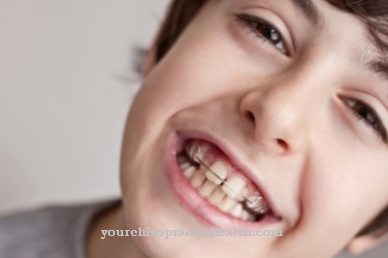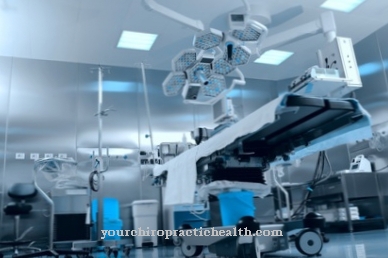A Breast pump, also Breast pump called, is used to express breast milk when there is no possibility of normal breastfeeding. The reasons for this can be varied. So-called pump breastfeeding has both advantages and disadvantages.
What is a breast pump?

The breast pump can help bridge the baby's breast milk supply in situations where normal breastfeeding is impossible. Often there are health reasons for the mother or child. But time restrictions, for example due to work, can also affect the rhythm of breastfeeding.
With the help of the breast pump, breast milk is sucked out of the breast through stimulation and negative pressure generation. The mother's ability to breastfeed remains intact even in times of non-breastfeeding because the stimulating stimulus is still present.
Technically, the breast pump, like the baby, creates a suction reflex through negative pressure, which stimulates the flow of milk via the natural milk donation reflex. The breast milk is then filled into bottles and can be stored under refrigeration. The baby does not drink from the breast, but from the bottle.
Another advantage of expressing milk is that there is no need to use replacement milk. The baby receives all the necessary nutrients through breast milk.
Shapes, types & types
There are several types of breast pumps commercially available. Manual and electric breast milk pumps are on offer. Depending on the design, one-sided or two-sided pumping is possible. There are also pumps that can be operated by hand or hands-free.
Electric pumps can adjust the suction pressure, the suction rhythm and the suction frequency. Electric pumps that can express from both breasts at the same time are particularly suitable for stimulating milk production. This creates a stimulus that sustains lactation for a long time. Various sizes are available to adapt the pump opening to the size of the nipple.
If there is a medical indication, the breast pumps can also be rented from pharmacies or hospitals with a prescription. The accessories of a breast pump also include milk bottles with teats, bottle warmers, a sterilization device and special freezer bags for freezing breast milk.
Structure & functionality
For pumping, the breast pump is placed on the breast using a glass or plastic attachment. During the pumping process, a negative pressure is created which then sucks the breast milk out of the breast. The top sections are made of skin-friendly and food-safe materials to avoid allergies.
The pumping process is divided into a stimulation and a pumping phase. In the stimulation phase, the milk flow is stimulated by the milk ejection reflex. The milk dispensing reflex, also known as the ejection reflex, describes the reflex generated by sucking to stimulate milk delivery. In this case, the suction reflex is created by the negative pressure of the breast pump. In a second phase, the actual expressing of the breast milk takes place.
The process of expressing milk requires a stress-free environment. In contrast to breastfeeding, pump breastfeeding has to be learned first. The presence of the baby, gentle breast massages, adequate nutrition, fluid intake and much more are factors that can positively support the pumping process.
Rapid pumping mimics the baby's sucking phase and thereby stimulates the milk flow reflex. After about three minutes, the milk can be expressed. In order to stimulate milk production, the entire process should take about ten to twenty minutes, even if there is no milk in the meantime.
It is advisable to perform breast pumping during stress-free times, to cool the milk and to warm it up again if necessary. It is also necessary to adjust the amount of milk expressed to the baby's drinking needs. The average drinking requirement of an infant is between 600 and 1200 ml of milk. However, this is only a very rough guide. Basically, the amount depends on the child themselves, their age and weight.
For continuous milk production, it is more effective to pump more often than to increase the pumping time. In this way, the stimulus becomes effective more quickly. The bilateral pumping process promotes milk. Therefore, the breast should be changed more often when pumping on one side. In the longer term, it makes sense to repeat the pumping process every four to six hours.
For weaning, the pumping time and frequency are gradually reduced. The weaning process can be controlled better with pump breastfeeding than with normal breastfeeding.
Medical & health benefits
The use of breast pumps is necessary in the case of certain illnesses in the child or mother. In children, pump breastfeeding is indicated for cleft lip and palate, premature babies, general weakness or breastfeeding strike of the infant.
For example, mothers can experience frequent nipple inflammation, with breastfeeding exacerbating the inflammatory process. Temporal problems or stress also often play a role in a disturbed breastfeeding process.
Pump-breastfeeding using a breast pump offers the possibility of supplying the infant with the mother's milk despite breastfeeding problems. The milk composition is best adapted to the needs of the infant and there is no need to use milk substitutes. This has a strengthening effect on the baby's immune system.
In addition, pump-breastfeeding also maintains lactation. Later breastfeeding is possible again more quickly. By expressing the milk, a blockage of the milk can be better avoided and weaning can be regulated more easily than with normal breastfeeding.
The lack of physical contact between mother and child has a negative effect, which in turn occurs in the breastfeeding phase and plays an important role in bonding and the security of the child.
The breast pump and its accessories also need to be purchased and require regular sterilization. In the case of breastfeeding problems, however, pump breastfeeding via the breast pump is the much better alternative for the infant compared to milk substitute food.

























.jpg)


